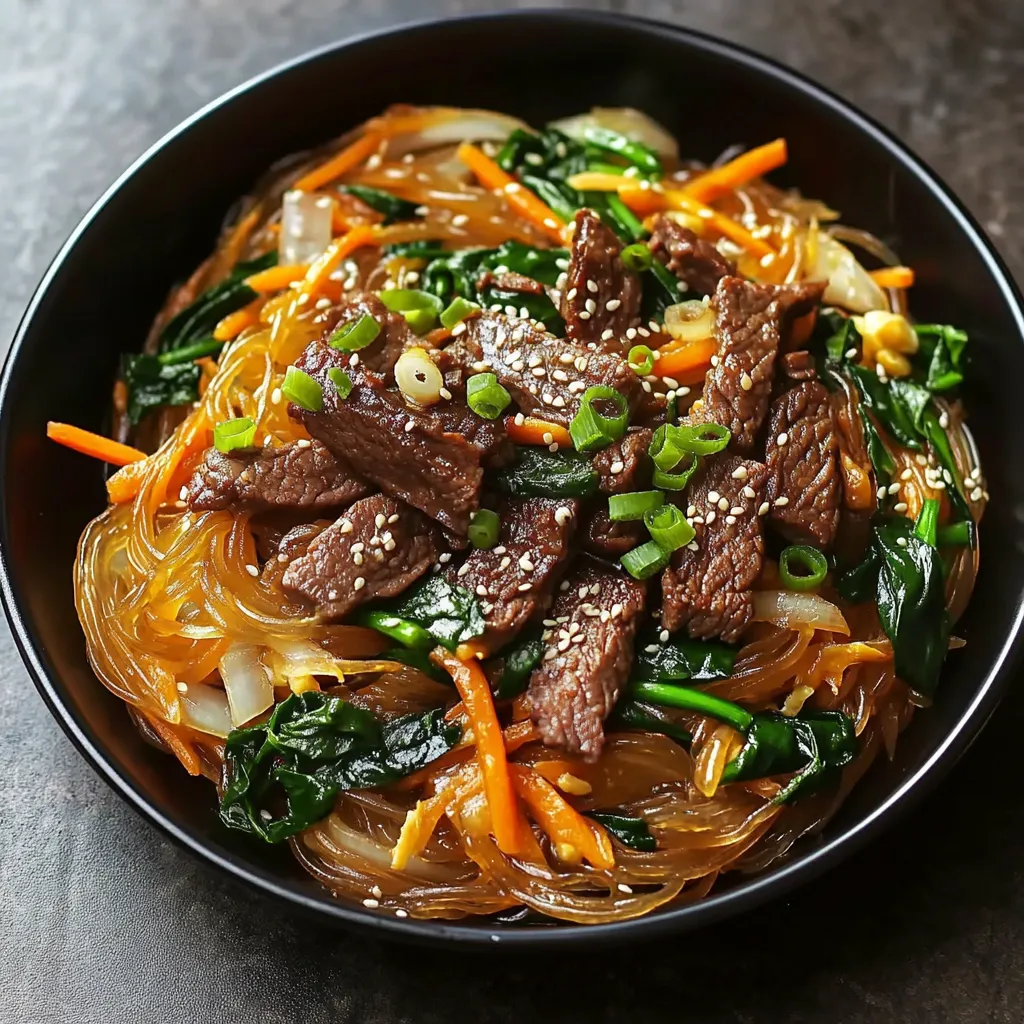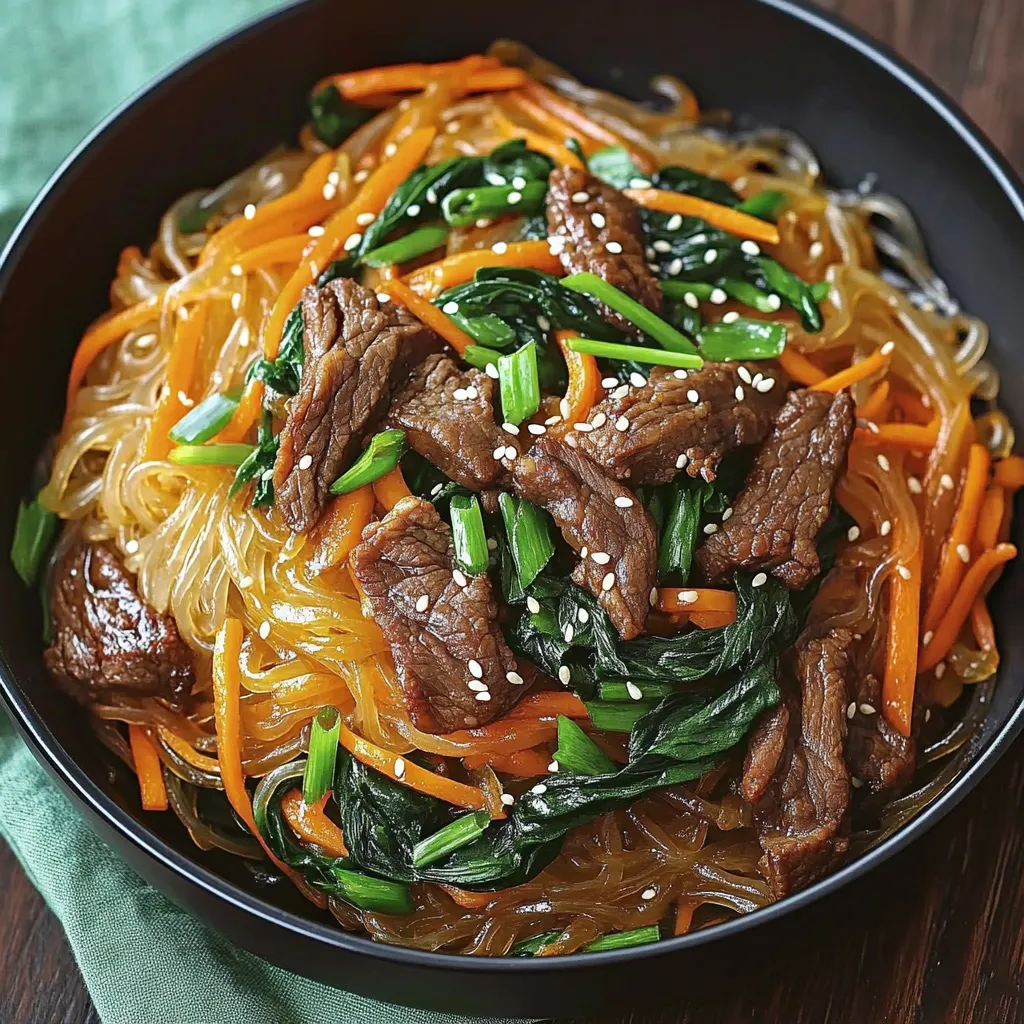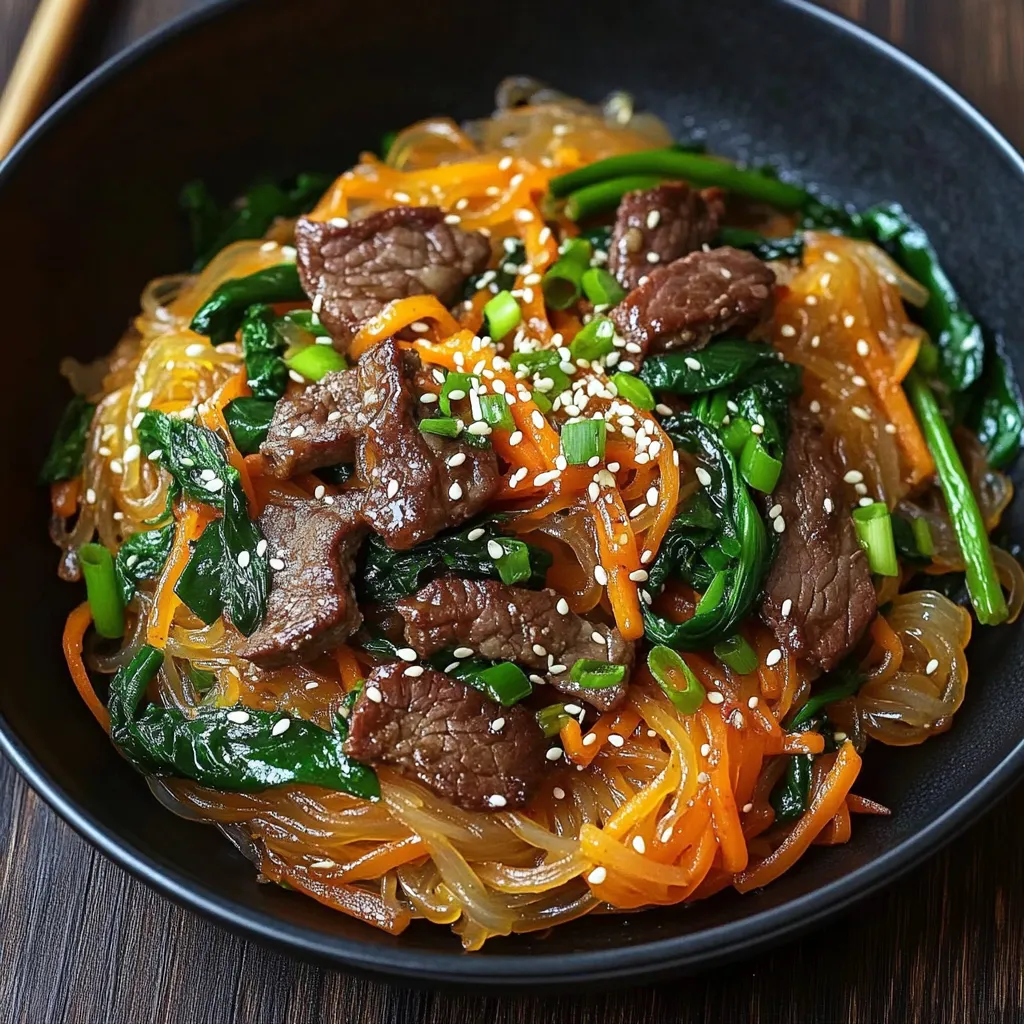 Pin it
Pin it
Chewy glass noodles made from sweet potatoes, juicy beef slices, and shiny, colorful veggies all get tossed together for the ultimate Korean comfort food. You end up with bouncy noodles that grab every bit of that sweet, salty, and nutty sauce—the kind you wanna keep slurping. Crunchy carrots, soft spinach, mushrooms, and onions bring a rainbow to your bowl and a mix of healthy goodness. Top this off with some toasted sesame seeds and chopped green onion, and every bite feels special. No wonder folks love it for big parties or just a regular dinner—it’s simple, full of flavors, and always a hit worldwide.
I remember first trying this dish in college when my roommate from Korea made it for an international dinner. Those springy noodles in a rich sauce totally wowed me. After lots of trial runs in my kitchen, I finally nailed that perfect glass noodle bite and now it’s my favorite go-to whenever I want to impress friends at home.
Irresistible Ingredients
- Fresh Ginger: Throws in warm, zesty flavor to the sauce.
- Toasted Sesame Seeds: Give a little crunch and a nutty finish right before you dig in.
- Neutral Cooking Oil: Lets you stir everything up without changing the main flavors.
- Brown Sugar: Sweetens things up to balance out the salty soy sauce.
- Garlic: Boosts the savory vibes so nothing tastes flat.
- Green Onions: For a mild onion punch as a fresh topper.
- Carrots: Bring a pop of orange and a natural sweetness.
- Spinach: Adds a hit of green color and lots of nutrients.
- Shiitake Mushrooms: Earthy mushrooms that match up with the meat and sauce.
- Beef Sirloin: Juicy protein that makes this dish super tasty.
- Soy Sauce: Lays down all that classic salty-sweet base.
- Sesame Oil: Fills the dish with a nutty smell and rich flavor.
- Sweet Potato Glass Noodles: These bouncy noodles give the dish its one-of-a-kind chewiness.
Simple Steps
- Rest For Flavor
- Let everything chill together for five minutes before eating to bring out the taste, whether you're serving it cold or warm.
- Finish With Crunch
- Just before serving, toss on your chopped green onions and sprinkle on sesame seeds for that last bit of crunch.
- Time To Combine
- Throw the noodles with the sauce, then add all veggies and meat, mixing until every bite is coated.
- Stir Fry Time
- Start by cooking your beef, then do onions, mushrooms, white bits of green onions, and carrots one by one in the pan.
- Mix Up The Sauce
- In a bowl, whisk together soy sauce, sesame oil, brown sugar, ginger, and garlic until it all blends nicely.
- Get The Veggies Ready
- Cut up carrots, blanch the spinach quickly, slice onions and mushrooms, then separate the green and white bits of your green onions.
- Flavor The Beef
- Marinate your sirloin with soy sauce, sesame oil, garlic, and sugar to give it a flavor boost.
- Noodles First
- Boil up the glass noodles till clear and chewy, rinse under cold water, and toss with a bit of sesame oil to keep them from sticking.
 Pin it
Pin it
My Korean teacher always pointed out how important it is to show off five colors in classic dishes. This one’s a perfect example—each veggie not only looks great but brings its own nutrients and some cool symbolism, too.
How To Serve
Warm it up with some kimchi and steamed rice if you want to go full Korean, or serve it cold with cucumber and radish on hot days for a crisp, chill bite.
Twist It Your Way
Try swapping in chicken or shrimp for the beef, load it with more mushrooms for a veggie style, or shake things up with gochujang if you like it spicy.
Leftover Tips
Pop any extras in a sealed container in the fridge—good for four days. Just heat it gently with a splash of water so the noodles get their spring back.
 Pin it
Pin it
This dish really nails what makes Korean food awesome—lots of color, a ton of different textures, and balanced flavors that make any meal feel special, whether it’s a celebration or just a chill night in.
Frequently Asked Questions
- → Where do I buy Korean glass noodles?
- Look for dangmyeon (sweet potato glass noodles) in Korean or Asian supermarkets—packaged as glass or sweet potato noodles. You can also get them on Amazon or other online food shops if stores near you don't carry them.
- → Is it easy to make Japchae meatless or vegan?
- You totally can! Skip the beef and add in things like sliced mushrooms, zucchini, or bell pepper for a veggie version. For vegan, just make sure your soy sauce isn’t made with fish. The dish is still legit without meat.
- → Can I prep Japchae ahead of time?
- Yes, it gets even better after it sits for a while. You can fix it a couple days early and store in the fridge. Let it sit out a bit or warm it up gently when you’re ready to eat—great for meal prep or get-togethers.
- → What beef should I pick for Japchae?
- Go for ribeye or sirloin—they stay soft and juicy when stir-fried. Choose marbled cuts, slice thin (it’s easier if you chill the meat first). Pork, chicken, or shrimp can also work if you want to swap it out.
- → Why are my glass noodles sticking together?
- Usually that happens if you don’t coat them in oil while still warm. Rinse boiled noodles in cold water, then add a splash of sesame oil right away and mix well. Don’t overcook—just chewy is perfect. If they’ve already stuck, gently heat them with a bit of water.
- → How should you serve Japchae—hot or cold?
- Room temp or barely warm is the usual way. That lets all the flavors come through and the noodles feel just right. You can eat it cold, too, especially when it’s hot out. Makes it perfect for parties and anywhere you need something you can make ahead.
